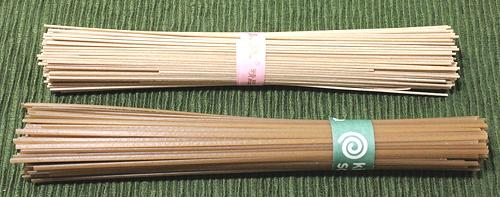 [nihon-soba, wa-soba, Yamato-soba]
[nihon-soba, wa-soba, Yamato-soba]
Buckwheat was being used in Japan from Neolithic times, but never in great quantity. A monk named Enni is credited for bringing the method of making Soba and Udon noodles from China, a little before 1280 CE. Today, Soba noodles are very popular in Japan, served cold in the Summer and hot in broth in the Winter.
At the top of the photo to the left are the regular Soba noodles common here in California. They are typically 7-3/4 inches long, 0.050 inches wide, 0.045 inches thick (197mm x 1.3 mm x 1.1 mm). They are usually sold in bundles of about 75 grams (2.7 ounces). Wheat flour is the first ingredient with Buckwheat flour second [Niwari soba]. In Japan that order is usually reversed with 80% buckwheat [Hachiwari soba]. All the ones I have purchased are from Korea or China. Korea is our primary provider of Japanese foods here.
At the bottom of the photo to the left are 100% Buckwheat Soba [Juwari Soba]. This version is gluten free and safe for celiac sufferers. It is, however, a little trickier to cook, being more fragile. They are typically 8-1/2 inches long, 0.075 inches wide, 0.035 inches thick (216 mm x 1.9 mm x 0.9 mm). Those in the photo were in 79 gram (2.7 ounce) bundles.
Other versions are: Cha soba colored and flavored with Green Tea - typically 95% wheat, only 3% Buckwheat, 2% Green Tea Powder. Sarashina soba is made of refined buckwheat flour and is a pale off-white. Yabu soba is made including buckwheat skins and is pale green. Inaka soba is very dark, made with unhulled buckwheat ground somewhat coarse.
During warmer months, soba is usually served cold with dip and dressing on the side. Outside Japan they are more typically served as a salad. For examples see our recipes Zaru Soba and Soba Noodle Salad.
More on Asian Noodles.